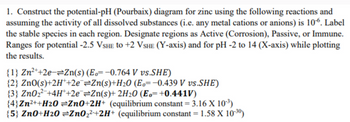
Principles of Modern Chemistry
8th Edition
ISBN: 9781305079113
Author: David W. Oxtoby, H. Pat Gillis, Laurie J. Butler
Publisher: Cengage Learning
expand_more
expand_more
format_list_bulleted
Question

Transcribed Image Text:1. Construct the potential-pH (Pourbaix) diagram for zinc using the following reactions and
assuming the activity of all dissolved substances (i.e. any metal cations or anions) is 106. Label
the stable species in each region. Designate regions as Active (Corrosion), Passive, or Immune.
Ranges for potential -2.5 VSHE to +2 VSHE (Y-axis) and for pH -2 to 14 (X-axis) while plotting
the results.
{1} Zn²++2e−=Zn(s) (E。= -0.764 V vs.SHE)
{2} ZnO(s)+2H++2e¯¯=Zn(s)+H₂O (E。=-0.439 V vs.SHE)
{3} ZnO2+4H+2e¯=Zn(s)+ 2H2O (E0= +0.441V)
{4}Zn²++H20=Zn0+2H+ (equilibrium constant = 3.16 X 10-³)
{5} ZnO+H20=ZnO₂²+2H+ (equilibrium constant = 1.58 X 10-30)
SAVE
AI-Generated Solution
info
AI-generated content may present inaccurate or offensive content that does not represent bartleby’s views.
Unlock instant AI solutions
Tap the button
to generate a solution
to generate a solution
Click the button to generate
a solution
a solution
Knowledge Booster
Similar questions
- This is an unknown solution which comprises of several ions possible for analysis. From the given information, determine which ions are present. Use + for positive, - for negative, or ? for insufficient information. An unknown solution containing the ions listed to the right was found: For Group I Cations: 1). A white precipitate was generated when 2 drops of 6M HCl solution was added to the unknown solution test tube. 2). Di water was added to the solution from part 1, and then the ppt was separated from the supernatant. The ppt was then washed with DI water few times to make sure is ppt is clean. 3). On the ppt separated from part 2 excess 6M NH3 was added and as a result all the ppt was dissolved. For Group III Cations: 4). An addition of Excess 6M NH3 led to a basic solution and a ppt. The ppt was then separated from the supernatant. 5). When Excess 6M NaOH was…arrow_forwardComplete and balance the following half-reaction in basic solution So3" (aq) – SO,? (aq) 3- 04- O- 03+ 04+ + 1 2 6. 7 8 9. O3 Os O6 O7 O8 O9 (s) (g) (aq) + H;0* H2O OH e H* H. Reset • x H2O Delete + 1L LO 4.arrow_forwardAnswer both questions pleasearrow_forward
- A 295-mL solution of NaCl was electrolyzed for 8.70 min. If the pH of the final solution was 12.05, calculate the average current used. A.arrow_forwardThe concentration of nitrate, NO3-, in a water sample was determined using ion-selective electrode. A 25.00 mL of the sample is placed in a beaker and a potential of 0.102 V is obtained. A 1.00 mL aliquot of a 200.0 mg/L standard solution of NO3- is added to this sample which gave a potential reading is 0.089 V. What is the concentration (ppm) of NO3- (FW = 62.00 g/mol) in the water sample?arrow_forwardCalculate the activity of Al3+ in a solution that is .0547M in Al2(SO4)3.arrow_forward
- 21. (What exactly is meant by potentiometric methods? What are they even?)arrow_forwardConsidering an experiment of using electrolysis to make bleach: (a) What would the effect be of changing the salt concentration and current on the final concentration of bleach? (b) What are the factors and tradeoffs (energy, time, etc.) to consider between using a lower current and higher current? Which would be preferred and why?arrow_forwardQ4. If an electrolysis experiment, 1.46g of zinc is deposited on one of the electrodes from a zinc sulphate solution. If the electric current used is 1.2A for a time of one hour, calculate the mass of a zinc atom. Electric charge on an electron= 1.6 × 10 to-19 C.arrow_forward
- A steady current of 10 A maintained for 1 hr deposits 12.2 g of zinc at the cathode. What is the equivalent mass of zinc?arrow_forwardConsider the following cell reaction: Ni(s) + 2 H*(? M). Ni?*(1.00 M) + H2(g)(1.00 atm) If the cell potential at 298 K is 0.118 volts, what is the pH of the hydrogen electrode? pH =arrow_forwardplease help and show work. I'm stuckarrow_forward
arrow_back_ios
SEE MORE QUESTIONS
arrow_forward_ios
Recommended textbooks for you
 Principles of Modern ChemistryChemistryISBN:9781305079113Author:David W. Oxtoby, H. Pat Gillis, Laurie J. ButlerPublisher:Cengage Learning
Principles of Modern ChemistryChemistryISBN:9781305079113Author:David W. Oxtoby, H. Pat Gillis, Laurie J. ButlerPublisher:Cengage Learning ChemistryChemistryISBN:9781305957404Author:Steven S. Zumdahl, Susan A. Zumdahl, Donald J. DeCostePublisher:Cengage Learning
ChemistryChemistryISBN:9781305957404Author:Steven S. Zumdahl, Susan A. Zumdahl, Donald J. DeCostePublisher:Cengage Learning Chemistry: An Atoms First ApproachChemistryISBN:9781305079243Author:Steven S. Zumdahl, Susan A. ZumdahlPublisher:Cengage Learning
Chemistry: An Atoms First ApproachChemistryISBN:9781305079243Author:Steven S. Zumdahl, Susan A. ZumdahlPublisher:Cengage Learning
 Physical ChemistryChemistryISBN:9781133958437Author:Ball, David W. (david Warren), BAER, TomasPublisher:Wadsworth Cengage Learning,
Physical ChemistryChemistryISBN:9781133958437Author:Ball, David W. (david Warren), BAER, TomasPublisher:Wadsworth Cengage Learning,

Principles of Modern Chemistry
Chemistry
ISBN:9781305079113
Author:David W. Oxtoby, H. Pat Gillis, Laurie J. Butler
Publisher:Cengage Learning


Chemistry
Chemistry
ISBN:9781305957404
Author:Steven S. Zumdahl, Susan A. Zumdahl, Donald J. DeCoste
Publisher:Cengage Learning

Chemistry: An Atoms First Approach
Chemistry
ISBN:9781305079243
Author:Steven S. Zumdahl, Susan A. Zumdahl
Publisher:Cengage Learning


Physical Chemistry
Chemistry
ISBN:9781133958437
Author:Ball, David W. (david Warren), BAER, Tomas
Publisher:Wadsworth Cengage Learning,